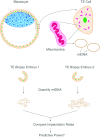Is mitochondrial DNA quantitation in blastocyst trophectoderm cells predictive of developmental competence and outcome in clinical IVF?
- PMID: 29080967
- PMCID: PMC5714830
- DOI: 10.1007/s10815-017-1072-6
Is mitochondrial DNA quantitation in blastocyst trophectoderm cells predictive of developmental competence and outcome in clinical IVF?
Abstract
Behind every successful IVF embryo transfer, there is a great game of chance. Methods seeking to tilt the balance and increase the likelihood of implantation have been proposed and implemented with varying results, including embryo morphology, FISH-PGS, comprehensive chromosomal screening (CCS), morphokinetics, endometrial receptivity testing. It has been suggested that mitochondrial DNA (mtDNA) copy number could serve as a biomarker for embryo viability, but this concept was recently challenged. The world of IVF is left with unanswered questions: Why are there discrepancies in the reports? Should mtDNA copy number be considered to rank embryos for transfer? And in a broader sense, how well must a technique be validated before its implementation in the IVF clinic? Here, we explore these questions attempting to piece together the published data and suggest future directions to help unravel the subject matter.
Keywords: IVF embryo selection; Mitochondria; Mitochondrial DNA; mtDNA.
Figures
Similar articles
-
Correlation between standard blastocyst morphology, euploidy and implantation: an observational study in two centers involving 956 screened blastocysts.Hum Reprod. 2014 Jun;29(6):1173-81. doi: 10.1093/humrep/deu033. Epub 2014 Feb 26. Hum Reprod. 2014. PMID: 24578475
-
Levels of trophectoderm mitochondrial DNA do not predict the reproductive potential of sibling embryos.Hum Reprod. 2017 Apr 1;32(4):954-962. doi: 10.1093/humrep/dex034. Hum Reprod. 2017. PMID: 28333210 Free PMC article.
-
Mitochondrial DNA content is not predictive of reproductive competence in euploid blastocysts.Reprod Biomed Online. 2020 Aug;41(2):183-190. doi: 10.1016/j.rbmo.2020.04.011. Epub 2020 May 14. Reprod Biomed Online. 2020. PMID: 32600944
-
Mitochondrial DNA as a biomarker for in-vitro fertilization outcome.Curr Opin Obstet Gynecol. 2016 Jun;28(3):158-63. doi: 10.1097/GCO.0000000000000274. Curr Opin Obstet Gynecol. 2016. PMID: 27077472 Review.
-
Mitochondrial DNA quantity as a biomarker for blastocyst implantation potential.Fertil Steril. 2017 Nov;108(5):742-747. doi: 10.1016/j.fertnstert.2017.10.007. Fertil Steril. 2017. PMID: 29101999 Review.
Cited by
-
The effect of vitrification on blastocyst mitochondrial DNA dynamics and gene expression profiles.J Assist Reprod Genet. 2023 Nov;40(11):2577-2589. doi: 10.1007/s10815-023-02952-3. Epub 2023 Oct 6. J Assist Reprod Genet. 2023. PMID: 37801195 Free PMC article.
-
Mitochondrial DNA quantification correlates with the developmental potential of human euploid blastocysts but not with that of mosaic blastocysts.BMC Pregnancy Childbirth. 2023 Jun 15;23(1):447. doi: 10.1186/s12884-023-05760-w. BMC Pregnancy Childbirth. 2023. PMID: 37322435 Free PMC article.
-
mtDNA dynamics between cleavage-stage embryos and blastocysts.J Assist Reprod Genet. 2019 Sep;36(9):1867-1875. doi: 10.1007/s10815-019-01544-4. Epub 2019 Aug 7. J Assist Reprod Genet. 2019. PMID: 31392663 Free PMC article.
-
Comprehensive mitochondrial DNA analysis and IVF outcome.Hum Reprod Open. 2018 Dec 20;2018(4):hoy023. doi: 10.1093/hropen/hoy023. eCollection 2018. Hum Reprod Open. 2018. PMID: 30895263 Free PMC article.
-
Cleavage stage mitochondrial DNA is correlated with preimplantation human embryo development and ploidy status.J Assist Reprod Genet. 2019 Sep;36(9):1847-1854. doi: 10.1007/s10815-019-01520-y. Epub 2019 Jul 10. J Assist Reprod Genet. 2019. PMID: 31292817 Free PMC article.
References
-
- Fragouli E, Spath K, Alfarawati S, Kaper F, Craig A, Michel CE, et al. Altered levels of mitochondrial DNA are associated with female age, aneuploidy, and provide an independent measure of embryonic implantation potential. PLoS Genet. 2015;11(6):e1005241. doi: 10.1371/journal.pgen.1005241. - DOI - PMC - PubMed
Publication types
MeSH terms
Substances
LinkOut - more resources
Full Text Sources
Other Literature Sources


